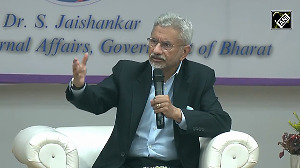Will the Gulf of Mannar, the 'Paradise of Biologists', be lost or saved due to indiscriminate fishing? This is the question often posed by environmentalists.
Hope has emerged in the form of Gulf of Mannar Biosphere Reserve Trust, which has launched a conservation programme by creating awareness among the people residing along coastal areas of Ramanathapuram and Tuticorin Districts of Tamil Nadu.
When Gulf of Mannar was declared a Marine National Park in 1986 and as a bio-reserve three years later, it was thought the flora and fauna would remain intact as fishing activities were restricted in the 10,500 square kilometre area. But mere declaration and law could not effectively protect the ecology.
According to S Ramasubramanian, an eco-development officer, "not much success could be achieved by law alone we understood that something more has to be done. So, it was suggested that alternative methods be adopted to protect the environment with the cooperation of the local populace, especially teachers and students of schools and fisherfolks."
Fortunately, the bio-reserve was among the World Network of Biospheres. The United Nations Development Programme with the Global Environment Facility, allocated $ 7.5 million for protecting bio-diversity of the Gulf.
According to Ramasubramanian, the Government of India and the Government of Tamil Nadu also co-financed the project that totalled $ 26.5 million.
He claimed that after introducing the richness of the Gulf of Mannar to fishermen and how it could help them earn more money if it was protected, at least a section of them volunteered not to use the banned nets for fishing.
Several misconceptions were cleared and fishermen knew that coral reefs were breeding centres of fish and it was essential to protect them for sustained fish-catch.
The intiative to educate the fishermen has begun with educating students and teachers. It would strengthen the role of the community in managing the reserve in ways that were ecologically sound, equitable for groups with a stake in the unique area.
"We cannot all of a sudden tell people not to fish and restrict them. They need to be educated. To some extent we are successful. The future generation now knows indiscriminate fishing affects hatcheries and fish population," said Ramasubramanian. In each batch about 30 teachers are introduced to the Gulf of Mannar who are taken to 21 islands, from the one closest to the coast just 500 metres away.
In the shallow waters around the islands, one can see the unique endemic organisms called "Balanoglosus" (Ptych dera flora) a taxonomically unique living thing that links vertebrates and invertebrates. 3600 species of plants and animals and 117 species of corals in seven genera are present in the Gulf of Mannar.
The GMBRT plans to establish 220 National Green Corps units in schools situated along the coast of Ramanathapuram and Tuticorin districts.
Aganus Virgin, another teacher, says school children from coastal villages should also be brought to the islands for first-hand information about the gulf. They, in turn, would influence their parents, the fisherfolks better than others.






 © 2025
© 2025